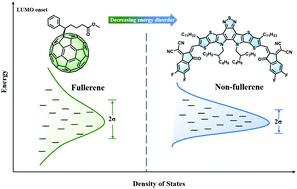当前位置:
X-MOL 学术
›
Energy Environ. Sci.
›
论文详情
Our official English website, www.x-mol.net, welcomes your
feedback! (Note: you will need to create a separate account there.)
Effects of energetic disorder in bulk heterojunction organic solar cells
Energy & Environmental Science ( IF 32.4 ) Pub Date : 2022-05-31 , DOI: 10.1039/d2ee00271j Jun Yuan 1 , Chujun Zhang 2 , Beibei Qiu 3 , Wei Liu 1 , Shu Kong So 2 , Mathieu Mainville 4 , Mario Leclerc 4 , Safa Shoaee 5 , Dieter Neher 5 , Yingping Zou 1
Energy & Environmental Science ( IF 32.4 ) Pub Date : 2022-05-31 , DOI: 10.1039/d2ee00271j Jun Yuan 1 , Chujun Zhang 2 , Beibei Qiu 3 , Wei Liu 1 , Shu Kong So 2 , Mathieu Mainville 4 , Mario Leclerc 4 , Safa Shoaee 5 , Dieter Neher 5 , Yingping Zou 1
Affiliation

|
Organic solar cells (OSCs) have progressed rapidly in recent years through the development of novel organic photoactive materials, especially non-fullerene acceptors (NFAs). Consequently, OSCs based on state-of-the-art NFAs have reached significant milestones, such as ∼19% power conversion efficiencies (PCEs) and small energy losses (less than 0.5 eV). Despite these significant advances, understanding of the interplay between molecular structure and optoelectronic properties lags significantly behind. For example, despite the theoretical framework for describing the energetic disorder being well developed for the case of inorganic semiconductors, the question of the applicability of classical semiconductor theories in analyzing organic semiconductors is still under debate. A general observation in the inorganic field is that inorganic photovoltaic materials possessing a polycrystalline microstructure exhibit suppressed disorder properties and better charge carrier transport compared to their amorphous analogs. Accordingly, this principle extends to the organic semiconductor field as many organic photovoltaic materials are synthesized to pursue polycrystalline-like features. Yet, there appears to be sporadic examples that exhibit an opposite trend. However, full studies decoupling energetic disorder from aggregation effects have largely been left out. Hence, the potential role of the energetic disorder in OSCs has received little attention. Interestingly, recently reported state-of-the-art NFA-based devices could achieve a small energetic disorder and high PCE at the same time; and interest in this investigation related to the disorder properties in OSCs was revived. In this contribution, progress in terms of the correlation between molecular design and energetic disorder is reviewed together with their effects on the optoelectronic mechanism and photovoltaic performance. Finally, the specific challenges and possible solutions in reducing the energetic disorder of OSCs from the viewpoint of materials and devices are proposed.
中文翻译:

体异质结有机太阳能电池中能量无序的影响
近年来,通过开发新型有机光活性材料,特别是非富勒烯受体(NFA),有机太阳能电池(OSC)取得了快速发展。因此,基于最先进 NFA 的 OSC 已经达到了重要的里程碑,例如 19% 的功率转换效率 (PCE) 和较小的能量损失 (小于 0.5 eV)。尽管取得了这些重大进展,但对分子结构和光电特性之间相互作用的理解却大大落后。例如,尽管描述高能无序的理论框架已经在无机半导体的情况下得到了很好的发展,但经典半导体理论在分析有机半导体中的适用性问题仍然存在争议。无机领域的一般观察是,与无定形类似物相比,具有多晶微结构的无机光伏材料表现出抑制的无序特性和更好的电荷载流子传输。因此,该原理延伸到有机半导体领域,因为合成了许多有机光伏材料以追求类似多晶的特征。然而,似乎有零星的例子表现出相反的趋势。然而,将能量紊乱与聚集效应脱钩的全面研究在很大程度上被排除在外。因此,能量紊乱在 OSC 中的潜在作用很少受到关注。有趣的是,最近报道的最先进的基于 NFA 的设备可以同时实现小的能量紊乱和高 PCE;并且对这项与 OSC 中的无序特性相关的调查的兴趣重新燃起。在这篇文章中,回顾了分子设计和能量无序之间相关性方面的进展,以及它们对光电机制和光伏性能的影响。最后,从材料和器件的角度提出了减少 OSC 能量无序的具体挑战和可能的解决方案。
更新日期:2022-05-31
中文翻译:

体异质结有机太阳能电池中能量无序的影响
近年来,通过开发新型有机光活性材料,特别是非富勒烯受体(NFA),有机太阳能电池(OSC)取得了快速发展。因此,基于最先进 NFA 的 OSC 已经达到了重要的里程碑,例如 19% 的功率转换效率 (PCE) 和较小的能量损失 (小于 0.5 eV)。尽管取得了这些重大进展,但对分子结构和光电特性之间相互作用的理解却大大落后。例如,尽管描述高能无序的理论框架已经在无机半导体的情况下得到了很好的发展,但经典半导体理论在分析有机半导体中的适用性问题仍然存在争议。无机领域的一般观察是,与无定形类似物相比,具有多晶微结构的无机光伏材料表现出抑制的无序特性和更好的电荷载流子传输。因此,该原理延伸到有机半导体领域,因为合成了许多有机光伏材料以追求类似多晶的特征。然而,似乎有零星的例子表现出相反的趋势。然而,将能量紊乱与聚集效应脱钩的全面研究在很大程度上被排除在外。因此,能量紊乱在 OSC 中的潜在作用很少受到关注。有趣的是,最近报道的最先进的基于 NFA 的设备可以同时实现小的能量紊乱和高 PCE;并且对这项与 OSC 中的无序特性相关的调查的兴趣重新燃起。在这篇文章中,回顾了分子设计和能量无序之间相关性方面的进展,以及它们对光电机制和光伏性能的影响。最后,从材料和器件的角度提出了减少 OSC 能量无序的具体挑战和可能的解决方案。











































 京公网安备 11010802027423号
京公网安备 11010802027423号